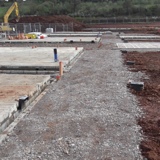Information
-
Document No.
-
Audit Title
-
Client / Site
-
Conducted on
-
Prepared by
-
Location
-
Personnel
Work at height
-
Fall Risk (including voids, pits, lorry beds and trenches) barrier protected to prevent persons from falling
-
Lack of edge protection around trenches, voids, to prevent material falling on operative near to edge or within void
-
Lack of fall arrest system (air bags, safety harnesses)
Safe Digging Procedure
-
CAT used prior to excavating (both CAT and Genny)
-
Permit to dig in place signed and dated by e site manager
-
Is there correct safety equipment (trench boxes or sheets) in place ready for use
-
Is there a safe means of access (correct ladder or stepped sides)
-
Is the machine the correct size and type to handle the the lifts ( chart in cab, driver trained, non return valves fitted, audible warning device of overload)
-
If over 900mm in depth is the trench properly supported or sides reduced by battering
-
Is the area completely confined by barriers to prevent unauthorised access
-
Possible contact with underground assets ? Identified and hand dug to note line and level (no machine dig within 500mm)
-
If overhead lines present are there correct warning barriers in place
-
Excavation register filled out prior to the start of a shift and /or after inclement weather, ( prior to any operative entering the excavation)
-
Bucket changing area in place and being used for all machines
Vibration
-
Is there a chart displayed to inform the operatives of the vibration usage times
-
Has all the equipment being used been identified to the operative stating the maximum trigger times not to be exceeded
-
Is the equipment in use regularly maintained as per the-manufacturers data, is the site able to confirm this
-
Is the daily record sheets up to date and contain the correct information
Confined Space access equipment
-
No damage to the rescue equipment
-
Equipment certificate of test in date
-
Equipment in use meets the lift requirement ( harness fitted correctly, correct type of harness, lanyard connected to the hoist)
-
Tripod correctly positioned, winch locked in place correctly top man able to operate equipment.
Confined Space working in
-
Permit tonWork filled out and filed
-
Is all signage and barriers in place as required to prevent unauthorised access
-
Communication medium established and checked if sufficient
-
All operatives carrying correct training cards for the task they are to perform
-
Is the correct procedure for the works being followed as relevant training
-
Is the gang correct size for the works minimum entry operative and top man
-
Is the analytical equipment calibrated and set correctly
-
Has the analytical equipment been used for 20minutes prior to entry to establish a safe atmosphere
Ladders
-
Is the ladder safe to use Undamaged and correct length
-
Is the ladder positioned correctly
-
Is the ladder secured correctly and suitable (not double extender)
-
Is any work being performed from the ladder are three points of contact being maintained
Hazardous Manual Handling Tasks
-
Has the manual handling task been correctly identified (weight, size, sharp edges etc.)
-
Is the task being performed correctly after identification
-
Is there adequate risk controls in place ( job rotation, trolleys etc.)
-
Has there been training undertaken by the operative in lifting techniques.
Hazardous Chemicals (including fuel oil and grease
-
Safe Storage location (away from ignition sources, away from storm drains and water courses)
-
No Incompatible chemicals stored near one another
-
Adequate spill containment (bunded area not overfull)
-
Safety Data sheets available on site
-
Adequate emergency procedure in place in case of fire /injury/spills
-
Excessive quantities not stored in vehicles or on site
-
Sufficient ventilation for chemical storage and usage
-
Suitable storage containers (correctly marked with contents)
Respiratory Protection
-
Are operatives aware of the risk
-
If cutting is there sufficient suppression (local exhaust ventilation / water suppression)
-
Have the operative been face fitted with the type and design of filters being used within the last 12 months
-
Is the respiratory equipment in a serviceable condition ( Undamaged, clean, maintained)
Emergency Response
-
Adequate first aid equipment for site ( consider number of operatives and type of work undertaken)
-
Access to formally trained first aides for all shifts
-
Suitable and adequate communication equipment
Traffic Management
-
Site Traffic Management plan being followed
-
Barriers being maintained after removal for our operations or disrupted due to access required by our machinery
-
Where general public have access are we adequately protected (physical barriers bollards speed limits etc.) or where other site traffic is generally accessing (forklifts in particular )
-
Route for emergency vehicles kept accessible
Personal Protective Equipment (P.P.E.)
-
Adequate protection (including sun protection) in use
-
P.P.E. in good condition not altered or damaged reflective bands still highly visible
-
Operatives instructed in the risk of skin damage ( toxins in the ground, sun damage)
-
Appropriate P.P.E. being used for the task being undertaken if additional hazards identified requiring specific P.P.E. (concreting , Tarmac laying)
Work Environment
-
Adequate amenities ( toilets, washing areas, eating facilities with tables and high backed chairs hot or warm water, drinking water, means of heating food)
-
Good housekeeping in sheds and welfare units ( tidy, trip hazards removed, correct signage I.e. fire diamonds on sheds containing flammable liquids)
-
Adequate noise control being deployed in areas where any operative will be exposed to greater than 85 Dba.
-
Signage in place to warn other operatives or public to keep clear of hazardous operations
-
Housekeeping on the site to the required standard (lack of trip hazards, broken pipes cut steel contained within a protected area)
Electrical Hazards
-
Safe electrical leads not damaged, and positioned to avoid trip hazard hazards and damage
-
110V, or battery only
-
Electrical equipment kept clear of fluids which may cause damage or short circuits
-
Electrical equipment kept clear flammable gases or liquids unless intrinsically safe
-
Electrical equipment either double insulated or power source RCD protected and earthed.
Environmental Hazards
-
Hazardous materials adequately contained (cement concrete washout area established ) away from drains and water course
-
Dust suppression system adequate and in use where required
-
Systems in place to prevent pollution or storm water drains and ditches (silt traps or other filtering medium in use)
-
Refuelling area correctly set with double bunded tank or other containment, away from drains and water courses
Administrative Procedures when P.C.
-
Adequate supervisory arrangements ( three day first aides etc.)
-
All operatives on site received a site Induction
-
Is there consultation arrangements for the workers and are they aware
-
Are there routine inspections for health and safety being carried out and a check sheet kept
-
Emergency plans in place ( route to hospital, emergency phone numbers etc.)
-
Emergency response displayed (fire assembly point etc.)
-
Site boundary for works totally secure from unauthorised access
-
Health and safety law poster displayed and correctly filled in
Chapter 8 works
-
Advanced signage in place
-
Pedestrian safety in place (barriers away from works or alternative safe routes displayed)
-
Traffic management plan in place agreed with the local authority and correctly implemented
-
Full type 3 P.P.E. worn by all operatives working in/adjacent to the highway
-
Supervisor with correct NSWA card checked the implication of the works prior to start <br>All operatives deployed in the works holding the correct NSWA cards
Site Machinery
-
Machine Operational area completely secure from other personal
-
All licences in place (12 month certificate etc.)
-
Has the machinery been signed off as checked for use today
-
All beacons working on active machines
-
All drivers holding relevant CPCS cards for the plant they are controlling
-
Slews fitted with quick hitch mechanism as requested by clients
-
Are seat belts being worn on machinery fitted with them by the operative
-
Machine disabled whilst driver out of seat (keys taken) and left in a safe condition(handbrake applied )
-
Is machinery being driven responsibly (not speeding)
-
Machine being used on stockpiles safe access egress no undermining if loading material away
Additional items / Not specified above
-
Any information not covered above
Advice given to correct actions
-
To whom
Corrective advice given to Contracts Manager
-
Enter actions suggested to Contract Manager
I have undertaken the corrective actions required Contracts Manager
-
Please sign







